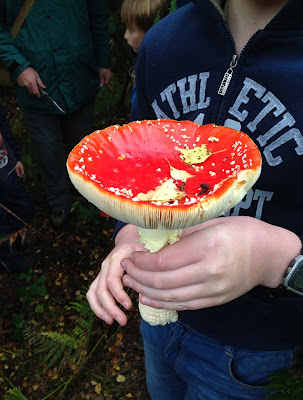We started at the visitor centre with a demonstration of woodturning by the West Riding Woodturners Group. It was really interesting for Otters to see how wood can be worked into useful and decorative items using traditional methods. The kids also got to take home games and ornaments made from turned wood.
Woodturning at St Ives Visitor Centre - Sunday 8th December 2013
Heading out for our walk - Sunday 8th December 2013
Continuing the wood and tree theme, we then went on a winter scavenger hunt, looking in particular for different types of tree. Identifying trees isn't as easy in winter as it is in summer, when the trees have their leaves. But, there there are still plenty of clues we can use to help us. Each different tree species tends to have a unique shape, so we can make a good guess at the species just by looking at the tree's silhouette. The bark's colour and texture is another really important clue. Underneath the tree you can look for clues such as dead leaves and fallen fruit, such as conkers from Horse Chestnut trees, acorns from Oak trees, and berries from Holly, Hawthorn or Rowan.
Different tree species can also have different buds on their twigs. The twigs may have thorns, and can branch in different ways depending on the species: opposite each other, or alternating left and right. So you can identify a tree just from a small stick found on the ground!
There were quite a few Black-headed Gulls on Coppice Pond, although none of them had black heads! This is because the birds only have black heads in spring and summer, and moult into different feathers in the autumn, so during winter their heads are mostly white with a small black dot behind the eye. We also saw Mallards, Canada Geese and Moorhens on the pond.
Canada Goose with Mallards at St Ives - Sunday 8th December 2013
We finished at the bird hide for snacks and mince pies, and hot juice and mulled wine. There were a few visitors to the feeders, including tiny Coal Tits. Coal Tits rarely hang around on the feeders. They like to fly in, quickly grab some food, and immediately fly off into cover to eat. We had some Blue Tits too, who are never as shy as the Coal Tits, plus the ground-feeding Dunnock. We were lucky to see two Nuthatches, if only briefly. And of course, no Christmas birdwatch would be complete without a Robin, and one sat in the fallen pine tree branch in front of the hide - a very festive scene.
Drinks and snacks at the bird hide - Sunday 8th December 2013
Once again, thank you to everyone who came and made it such fun event.





























































